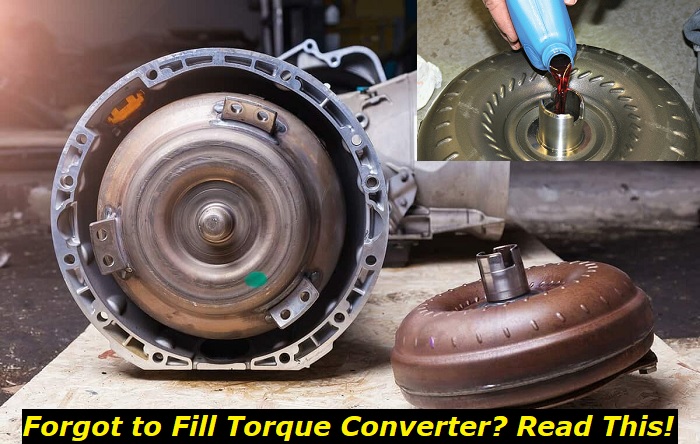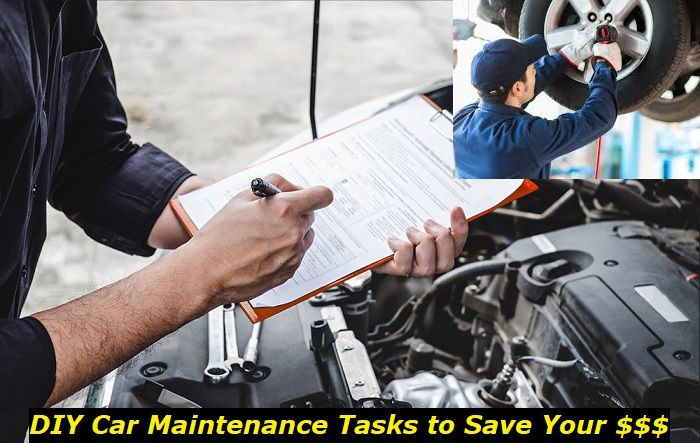In general, the lack of fluids on parts of your vehicle that need them can lead to dire consequences. So, the key rule is to make sure that the essential fluids like the engine oil, transmission fluid, coolant, brake fluid, power steering fluid, and washer fluid should always be topped up or at least within the recommended levels.
Fluid change in transmissions highlights
- Level of importance:High
- Time interval:Once every 60,000 miles or 10 years (if other not stated by the manufacturer)
- Needed expertise:High
- Needed tools:Basic set of car maintenance tools, plus car lift
- Time taken:2-4 hours
- Possible issues:Fatal failure of your transmission, jerking, harsh work, vibrations, limp mode, no shifting.

What the Torque Converter Does
The torque converter is an amazing addition to vehicles. As its name implies, it converts the torque coming from the engine.
This component makes sure that the torque generated from the engine is properly transmitted to the rotary system of the transmission. The main parts of the torque converter are the clutch, impeller, stator, and turbine. It also holds a certain amount of transmission fluid to ensure the proper lubrication of its moving parts to avoid too much friction and help in their cooling.
The benefits of a torque converter are numerous. It helps in smoother acceleration, offering better driving dynamics and improved fuel efficiency. The conversion process also allows more engine power to be sent to the transmission, resulting in increased acceleration performance. The torque converter can also reduce the load on the engine since it absorbs some of its force as opposed to a direct transfer from the engine. This helps protect it from stalling or overworking when shifting gears.
Another advantage of having a torque converter is that it acts as an additional layer of protection for the transmission system by smoothing out gear transitions and preventing any sudden jolts or jerks. Additionally, this feature aids in absorbing shocks and vibrations caused by uneven roads so you get a comfortable ride quality even in the bumpiest of terrains.
With these things in mind, it's no wonder why so many people consider this component an essential part of their vehicles.
How Much Fluid is Required for the Torque Converter
The torque converter requires a certain amount of transmission fluid to ensure its smooth operation. Generally speaking, the quantity of required fluid depends on the size and type of the torque converter being used. Most manufacturers and mechanics recommend having at least a quart of fluid in it upon installation to work well. Likewise, the fluid in the transmission reservoir should be full. Depending on the make and model of your vehicle, it's usually between 3 to 4 quarts.
It's important to note that using too much transmission fluid can be damaging to the torque converter while too little will reduce its effectiveness. Therefore, it's important to make sure you use the exact amount stated by your manufacturer.
It's advisable to check and replace the transmission fluid on a regular basis as part of general car maintenance practices, too. This helps ensure that all moving parts are properly lubricated and cooled, allowing them to function optimally. Moreover, it also helps extend the lifespan of the torque converter and its other components.
Consequences of Forgetting to Fill the Torque Converter with the Required Fluid
If by any chance you or your mechanic may have forgotten to pour at least a quart of the fluid upon the installation of a new torque converter or after servicing the part, you may be wondering what could happen to your vehicle.
Here's what the experts have to say about the matter:
1. Nothing as Long as You Have Enough Transmission Fluid in Your Vehicle's System
As a general rule, the consensus says that as long as your auto has an adequate amount of transmission fluid, it should have enough lubrication to drive the proper operation of the torque converter. All you have to do is start your engine until it reaches its ideal operating temperature and the transmission fluid should start circulating in its system, including the torque converter.
If the transmission fluid goes below the recommended mark as you go along, simply top it up. Just don't drive your vehicle until your transmission fluid reservoir is full to ensure that it has sufficient lubrication and there's enough fluid circulating in the torque converter.
Simply follow these steps to successfully check and fill up your transmission fluid:
- Before getting started, make sure your vehicle is parked on a level surface with the engine running and in neutral or park.
- First, locate the transmission dipstick. The location of the dipstick will vary depending on your vehicle's make and model but is usually located near the back of the engine block. If unsure, consult your owner's manual or a repair manual for the correct location.
- Pull out the dipstick and wipe it off with a clean rag. Reinsert the dipstick, then remove it again to check its level. The dipstick will generally have two height indicators on it which indicate the minimum and maximum levels of transmission fluid. Compare the level to these notches and determine if more fluid needs to be added.
- If additional fluid is needed, use a funnel to slowly fill in the correct amount of transmission fluid through the dipstick tube. It's important not to overfill, as this can damage the transmission. Once filled, replace the dipstick and check the level once more to make sure everything is correct.
- Finish things up by using a clean rag to wipe off any spilled fluid and dispose of it accordingly. Your vehicle's transmission should now be properly filled with the right amount of fluid, and you'll be ready to hit the road.
2. Damage to the Key Components of the Torque Converter
The previous item in this list is normally the case, however, it should be a different story altogether if you have also failed to fill up your transmission system with the right amount of fluid or if there's a clogging somewhere along the way to the torque converter.
In such cases, there's a high chance that your torque converter won't be able to receive the required fluid. This could lead to overheating, resulting in damage to its various key components such as the impeller and turbine blades. This may even eventually cause your engine to fail completely due to slippage in power transmission.
With this in mind, you should watch out for the primary symptoms of torque converter issues such as the following:
- Harsh or delayed shifting
- Lack of power when accelerating
- Grinding noises while shifting gears
- High stall speed and RPMs due to the transmission taking a longer time to engage the engine
- Jerking even driving on a smooth pavement
- Warning lights on the dashboard indicating a failure on the transmission control unit or transmission system
- Overheating, which is normally displayed by the temperature gauge on your vehicle's instrument cluster
If you notice any of the above symptoms, it's best to have your torque converter checked by a professional mechanic as soon as possible. Your mechanic can also inspect the fluid level of your transmission system and determine if it's running low or if there are any clogs. This step should help you avoid major damage to the torque converter in the long run.
Cost of Torque Converter Replacement
Always make sure that your torque converter has enough fluid in its system from the get-go. The failure to adhere to the recommendations of your vehicle manufacturer or mechanic increases your risk of incurring expensive repairs down the line due to parts damage.
A torque converter alone will cost you around $150 to $350 based on prevailing prices. If you know your way around a vehicle and you choose to do the repairs on your own, the DIY should sum up to $500, including the other materials essential for the job. This entails an estimated 5 to 10 hours of work though because you will need to detach the transmission in order to get access to the torque converter. Furthermore, you will likely need extra pair of hands for the heavy lifting required to get the entire transmission system off your auto.
On the other hand, should you decide to go on a safer route or if you don't have the right skills for the work, the overall cost of a torque converter replacement will take you around $600 to $1,000, including labor.
Do note that the reflected numbers may further increase if there are other parts that have been compromised due to the problems stemming from the torque converter issue.
Conclusion
Overall, having enough transmission fluid in your torque converter is essential for its proper functioning. These mainly contribute to your vehicle's smoother acceleration performance, better fuel efficiency, and reduced load on the engine as well as enhanced ride quality even on uneven roads. Combined with its other features such as shock absorption and gear transitioning ability, you can rest assured that your car will provide you and its occupants with extra perks when it comes to comfort.
The failure to directly top up the torque converter with fluid does not necessarily lead to significant damage to your vehicle as long as it has enough fluid in the reservoir of its transmission system. However, it is always recommended to follow your manufacturer's advice of ensuring that there's enough fluid in your torque converter upon installation to reduce your risk of running into trouble and guarantee the best running condition of your vehicle.
About the authors
The CarAraC research team is composed of seasoned auto mechanics and automotive industry professionals, including individuals with advanced degrees and certifications in their field. Our team members boast prestigious credentials, reflecting their extensive knowledge and skills. These qualifications include: IMI: Institute of the Motor Industry, ASE-Certified Master Automobile Technicians; Coventry University, Graduate of MA in Automotive Journalism; Politecnico di Torino, Italy, MS Automotive Engineering; Ss. Cyril and Methodius University in Skopje, Mechanical University in Skopje; TOC Automotive College; DHA Suffa University, Department of Mechanical Engineering






Add comment